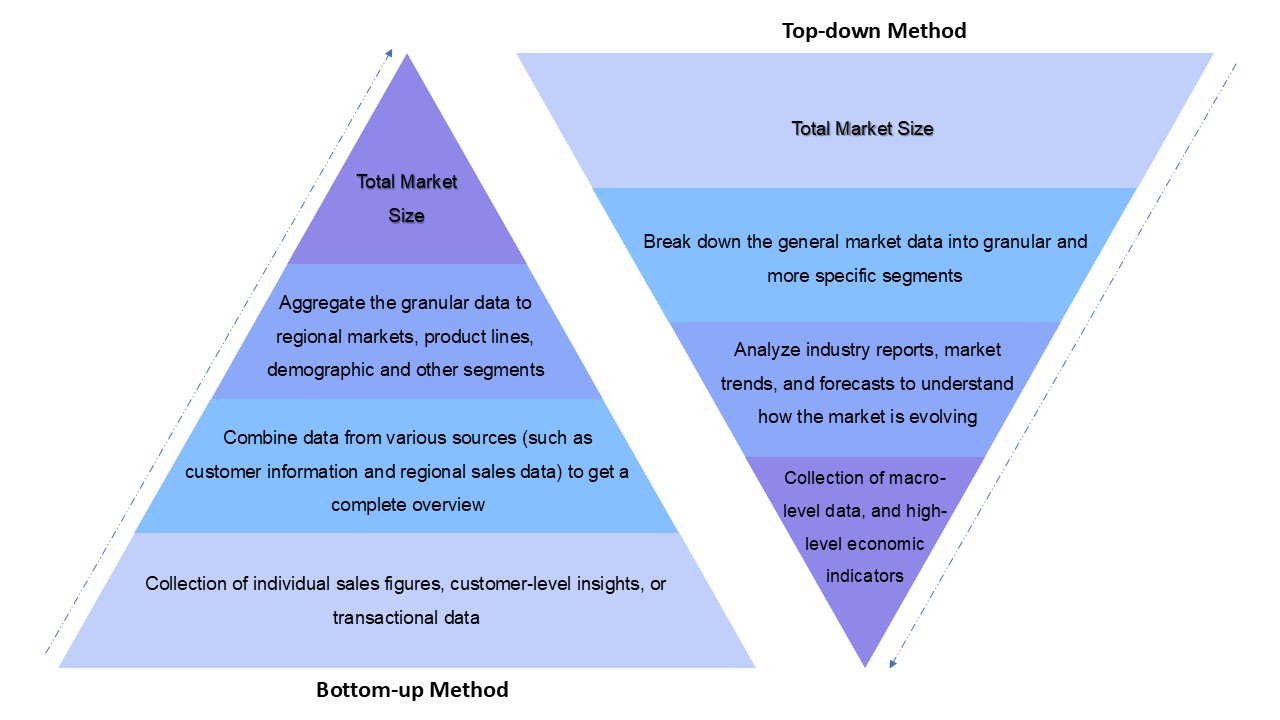Our research methodology begins with a clearly defined objective for the market study. The scope of each research report is designed to deliver exhaustive, in-depth insights into market size estimation, historical performance analysis, and growth forecasting (CAGR) across global markets, regional landscapes, segments, and country specific-segment market dynamics. We adopt both secondary and primary research methodologies to accurately evaluate market size and forecast growth (CAGR) for markets, segments, regions, and countries.
Our secondary research utilizes a comprehensive array of reliable secondary data sources, including in-house industry databases, government and intergovernmental publications, paid commercial databases, annual reports, SEC filings, investor presentations, press releases, and corporate governance documents. We leverage trade journals, white papers, and market intelligence platforms to examine historical data, identify industry trends to gain in-depth insights into market dynamics
We conduct a detailed study of macroeconomic factors for each market, such as GDP growth analysis, inflation trends, trade balance reviews, and fiscal policies, to understand broader economic factors influencing the market. Industry-specific macroeconomic indicators, like sectoral investments, export-import statistics, and employment data, are also examined to correlate economic conditions with market performance.
Additionally, we further incorporate a comprehensive regulatory analysis, examining government policies, compliance requirements, and regional regulatory frameworks. This helps us assess the impact of evolving regulations, certifications, and standards on the market’s dynamics and future growth potential.
The primary research data collection process is structured through surveys, interviews with subject matter experts (SMEs), industry leaders, and focus groups to gather various qualitative and quantitative datapoints. We have a dedicated resources to rigorously conduct interviews with target groups. Our primary research methods include in-depth interactions with various industry value-chain stakeholders, such as component suppliers, manufacturers, distributors, and aggregators. Through this extensive research methods, we derive authentic insights into current market trends, including growth-impacting drivers, restraints, opportunities, and challenges.
Upon collecting data and defining the research scope, qualitative and quantitative data analysis is conducted using advanced statistical modeling techniques and data triangulation methods. The analysis also focuses on key metrics, such as competitive benchmarking, SWOT analysis, Porter’s Five Forces, and PESTLE analysis.
FIG 1: Research Methodology Process

We employ both primary and secondary research methodologies to accurately estimate historical and base year market size for a specific product or service. This process incorporates demand-side analysis for evaluating the total demand across all customer/ buyers/ end-users’ segments and supply-side analysis to evaluate contributions from competitors/ suppliers/ distributors. We use advanced statistical methodologies to estimate and forecast market size for each region, country and segments, utilizing demand-side analysis, supply-side modeling, and validated data from both secondary and primary sources to ensure accurate and comprehensive market projections.
Using the Top-Down Approach, we start with broad macroeconomic data and refine it to estimate market size for specific products or services. The Bottom-Up Approach begins with granular data, such as individual sales or customer-level information, and scales it up to estimate the total market. Also, these methods were extensively utilized to estimate the market size of the sub-segments as well.
To calculate emerging and niche markets, we incorporate the TAM (Total Addressable Market), SAM (Serviceable Available Market), and SOM (Serviceable Obtainable Market) frameworks for precise market size evaluation. For TAM analysis, we utilize both the revenue-based approach and the volume-based approach, ensuring a comprehensive evaluation through robust market estimation techniques. Additionally, we also leverage value chain and sales funnel analysis to examine each stage of the value chain from raw materials to final product providing a detailed estimation of market size and value at every level.
FIG 2: Market Estimation Process

Our market research process combines both primary and secondary research methodologies. Primary research includes surveys, interviews, and focus groups with industry experts, stakeholders, and end-users. Secondary research leverages reliable sources such as industry databases, government publications, trade journals, and macroeconomic studies to validate and enhance findings.
We use both Top-Down and Bottom-Up approaches to estimate market size. The Top-Down approach starts with macroeconomic data and narrows down to specific markets, while the Bottom-Up approach starts with granular data, such as individual sales, and aggregates it to estimate the total market. We also incorporate the TAM, SAM, and SOM frameworks for accurate evaluations.
We use both historical data and advanced statistical modelling techniques to forecast market growth. Our forecasting process is driven by demand-side analysis (evaluating total demand across market segments) and supply-side analysis (assessing competitor and supplier contributions). These insights are refined using statistical tools and triangulated data to provide accurate, comprehensive market projections.
Data triangulation involves combining data from multiple sources to ensure accuracy and validity. We employ this technique by cross-verifying data collected from primary research (interviews and surveys) with secondary sources (industry databases, reports, and publications). This allows us to derive comprehensive insights and avoid biases in our findings
Data accuracy and reliability are ensured through rigorous validation processes. Primary data is gathered through extensive interviews with key stakeholders, while secondary data is sourced from trusted, high-quality platforms. Additionally, data triangulation methods are employed to cross-check information and confirm findings, ensuring high levels of confidence in the final reports.